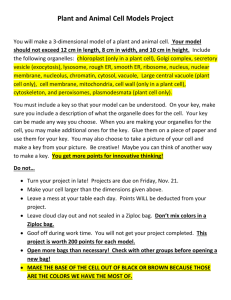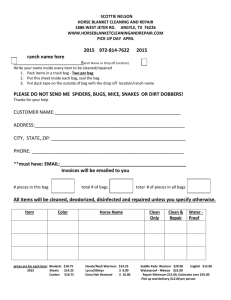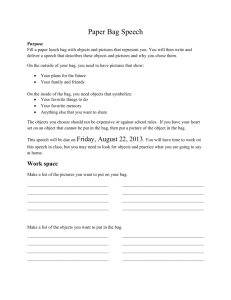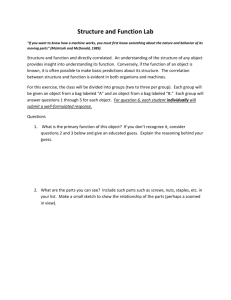Law of Conservation of Matter Lab Purpose
advertisement
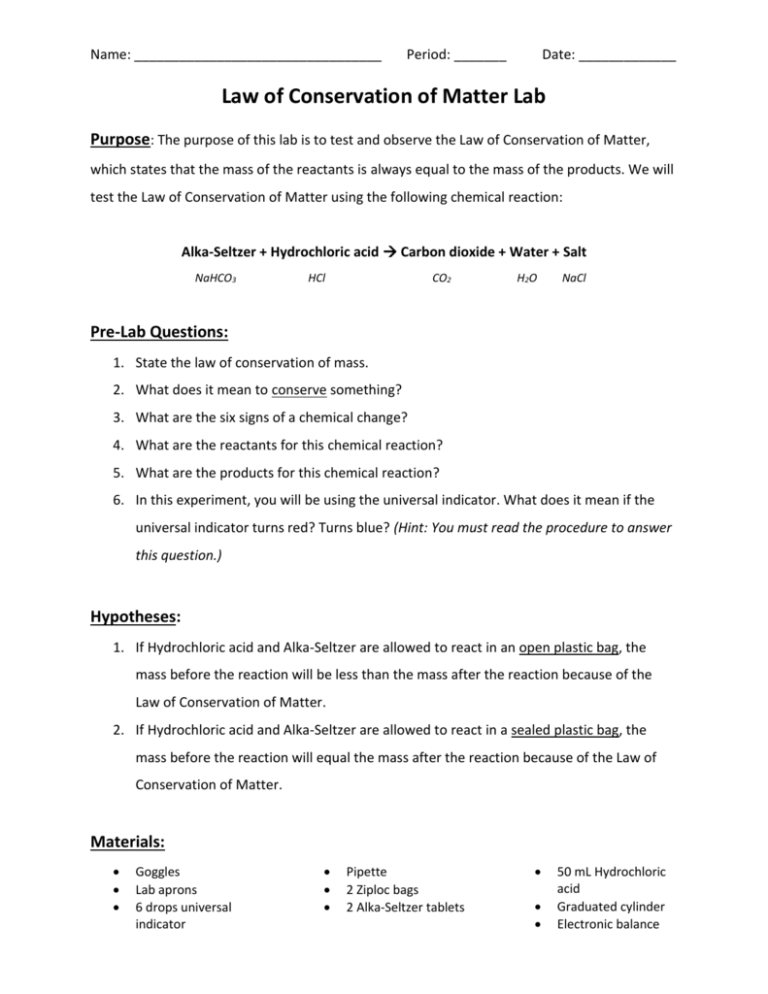
Name: _________________________________ Period: _______ Date: _____________ Law of Conservation of Matter Lab Purpose: The purpose of this lab is to test and observe the Law of Conservation of Matter, which states that the mass of the reactants is always equal to the mass of the products. We will test the Law of Conservation of Matter using the following chemical reaction: Alka-Seltzer + Hydrochloric acid Carbon dioxide + Water + Salt NaHCO3 HCl CO2 H2O NaCl Pre-Lab Questions: 1. State the law of conservation of mass. 2. What does it mean to conserve something? 3. What are the six signs of a chemical change? 4. What are the reactants for this chemical reaction? 5. What are the products for this chemical reaction? 6. In this experiment, you will be using the universal indicator. What does it mean if the universal indicator turns red? Turns blue? (Hint: You must read the procedure to answer this question.) Hypotheses: 1. If Hydrochloric acid and Alka-Seltzer are allowed to react in an open plastic bag, the mass before the reaction will be less than the mass after the reaction because of the Law of Conservation of Matter. 2. If Hydrochloric acid and Alka-Seltzer are allowed to react in a sealed plastic bag, the mass before the reaction will equal the mass after the reaction because of the Law of Conservation of Matter. Materials: Goggles Lab aprons 6 drops universal indicator Pipette 2 Ziploc bags 2 Alka-Seltzer tablets 50 mL Hydrochloric acid Graduated cylinder Electronic balance Procedure: Experiment 1 1. Add 3 drops of universal indicator to your bag. This will tell you the acidity of your solution. An orange or red color indicates that it is acidic, while a green or blue color indicates the solution is basic. Yellow color indicates a neutral solution. 2. Write down the color of the universal indicator in the Observations section. 3. Use the graduated cylinder to measure 25mL of hydrochloric acid, HCl, into a Ziploc bag. Seal the bag. 4. Record the mass of the plastic bag and acid in your Data Table. 5. Record the mass of the Alka-Seltzer tablet in your Data Table. 6. Calculate the mass of plastic bag + acid + Alka-Seltzer (#3 in Data Table). 7. Add the Alka-Seltzer tablet to the plastic bag and keep the bag open. Observe the reaction until it comes to a complete stop. Record your observations in the Observations section. 8. Write down the color of the universal indicator in the Observations section. 9. When the reaction is complete, record the mass of the bag and its contents in your Data Table. Then calculate #5 in your Data Table. Experiment 2 1. Add 3 drops of universal indicator to your plastic bag. This will indicate the acidity of your solution. An orange or red color indicates that it is acidic, while a green or blue color indicates the solution is basic. Yellow color indicates a neutral solution. 2. Write down the color of the universal indicator in the Observations section. 3. Use the graduated cylinder to measure 25mL of hydrochloric acid, HCl, into a Ziploc bag. Flatten the air out of the bag and SEAL IT. Be sure not to spill any of the hydrochloric acid. 4. Record the mass of the plastic bag and acid in your Data Table. 5. Record the mass of the Alka-Seltzer tablet in your Data Table. Calculate the mass of plastic bag + acid + Alka-Seltzer (#3 in Data Table). 6. Tip the bag sideways. While holding the bag sideways, add the tablet so that the tablet and acid do NOT mix. 7. Reseal the bag. Do not trap any extra air in the bag. 8. Let the tablet drop into the water. Observe the reaction until it comes to a complete stop. Record your observations in your Data Table. 9. Write down the color of the universal indicator in the Observations section. 10. When the reaction is complete, record the mass of the bag and its contents in your Data Table. Then calculate #5 in your Data Table. Observations: Data Table: Experiment 1: Open Bag Experiment 2: Sealed Bag 1. Mass of bag + acid 2. Mass of Alka-Seltzer tablet 3. Total mass of bag and contents before reaction (#1 + #2) 4. Mass of bag + products after reaction 5. Difference in mass of bag before and after reaction (#4 - #3) Conclusion Questions: Answer the following questions in COMPLETE SENTENCES in your science notebook. 1. Did you support or reject your hypotheses? Address each hypothesis separately. 2. Compare the difference in mass (#5 in your data table) in Experiment 1 and Experiment 2. Why is this number different for each Experiment? 3. Do your values for the total mass before and after Experiment 2 agree with the Law of Conservation of Mass? Explain in complete sentences. 4. Using the chemical reaction included in the Purpose, determine what gas is being produced in this reaction. 5. Which signs of a chemical change did you observe? 6. Which signs of a chemical change were NOT observed? 7. What happen to the acidity of your solution? What did you observe that supported this?

